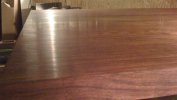More noob sharpening questions: How many steps?
I've seen a lot of content where people show their results after going through a series of different grit processes...going from more coarse to less coarse, and so on through several steps.
I've also seen content from folks using two steps (coarse and fine) showing great results. Heck, I've gotten pretty acceptable results using the Sharpal 162N as a total noob!
I've watched videos of people using sharpening wheels to get great results with a two step process (which feels more like a one step process...the second step feels more like polishing/stropping).
From what little I can understand, the entire point (ha!) of the sharpening process is to first create the desired angle of grind, then raise a burr, then use some method of removing the burr.
So....does one really need to (say) go through several different stones in the Edge Pro progression or several different bands for the Work Sharp KO in order to get really good results if you already have a reasonably good working knife?
I understand it depends on what you're starting with...a totally boogered blade vs. something in OK, just used condition. Am assuming most of my sharpening is going to be for knives that are in reasonably OK shape.
Am I just wasting time using the multiple stone progression or the multiple band progression?
BTW: I'm feeling a bit frustrated at not having some sort of objective/consistent way to measure the sharpness of the knives post sharpening. There's a part of me that feels that no matter what I've done, they COULD be sharper. While that is very likely to be true, it's also likely that there's a temptation to always be looking for way to get things sharper still, no matter how sharp things get.
Thanks!
Bruce
I've seen a lot of content where people show their results after going through a series of different grit processes...going from more coarse to less coarse, and so on through several steps.
I've also seen content from folks using two steps (coarse and fine) showing great results. Heck, I've gotten pretty acceptable results using the Sharpal 162N as a total noob!
I've watched videos of people using sharpening wheels to get great results with a two step process (which feels more like a one step process...the second step feels more like polishing/stropping).
From what little I can understand, the entire point (ha!) of the sharpening process is to first create the desired angle of grind, then raise a burr, then use some method of removing the burr.
So....does one really need to (say) go through several different stones in the Edge Pro progression or several different bands for the Work Sharp KO in order to get really good results if you already have a reasonably good working knife?
I understand it depends on what you're starting with...a totally boogered blade vs. something in OK, just used condition. Am assuming most of my sharpening is going to be for knives that are in reasonably OK shape.
Am I just wasting time using the multiple stone progression or the multiple band progression?
BTW: I'm feeling a bit frustrated at not having some sort of objective/consistent way to measure the sharpness of the knives post sharpening. There's a part of me that feels that no matter what I've done, they COULD be sharper. While that is very likely to be true, it's also likely that there's a temptation to always be looking for way to get things sharper still, no matter how sharp things get.
Thanks!
Bruce


